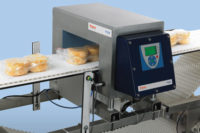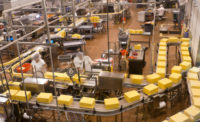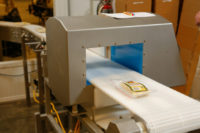In October, Kroger’s Turkey Hill Dairy, Conestoga, Pa., recalled packages of ice cream because of the possibility that some contained metal shavings. The products recalled were 1.5-quart packages of fudge ripple premium ice cream, pints of chocolate peanut butter cup premium ice cream and Moose Tracks Stuff’d frozen dairy dessert sold in Maryland, Pennsylvania and West Virginia. There were no reports of any foreign objects being found or any injury/illness occurring, according to a company press release.
Product recalls of this nature are rare, according to a U.S. Food and Drug Administration database. In a 60-day period, there were more food recalls related to undeclared allergens and Listeria monocytogenesthan of foreign objects found in packages.
Still, no processor wants to recall a food or beverage for any reason. And despite following good manufacturing processes, food companies know that there is always the possibility that foreign objects will find their way into packages. Detection systems are the last line of defense. Dairy Foodsinvited equipment suppliers to talk about their equipment.
Dairy Foods:What new technology or features have you incorporated into your equipment?
Dick Wyman, senior applications specialist, Mettler Toledo, X-ray: Mettler Toledo Safeline has developed and implemented “time delay detector technology.” This technology collects X-ray data much more efficiently and therefore allows the usage of lower wattage X-ray generators, that generate less heat and are lower in cost to buy and to operate.
Kelly Sharpe, marketing manager, Fortress Technology: Our new technology can dramatically increase the detector’s sensitivity in certain applications. This innovative technology can easily and affordably be installed into an existing Fortress detector.
Geri Foley, metal detection sales manager, Mettler Toledo product inspection: We have introduced the Zero Peripheral Metal Free Zone PRO ST detector that can detect metal particles as small as 0.5 millimeters in diameter.
John Uber, business development manager for food processing and packaging, Mettler Toledo hi-speed checkweighing: The introduction of an IP69k electromagnetic force restoration brings the best weighing technology into food production. The move to a well-protected weighcell means better weighing performance and reduced giveaway.
Laura Studwell, marketing manager, Loma Systems: We debuted the new X5 X-ray inspection system at Pack Expo Las Vegas. Loma is looking to put these systems right in the heart of processing. This means that X-ray systems now need to be as durable and hygienic as metal detectors. The X5 has rounded, sloping surfaces that ensure food particles and washdown droplets cannot accumulate on its surfaces, unlike equipment with flat surfaces. A quick-release mechanism allows the conveyor belt to be changed within a few minutes.
Loma also released three new technology enhancements to its flagship IQ3+ metal detector. The IQ3+ achieves a 20% increase in field strength [ensuring] greater sensitivity to contaminants in any type of application. EnviroScan software prevents vibrations from harsh washdowns or electrical interference from impairing detection performance.
Bob Ries, lead product manager, metal detection and X-ray inspection, Thermo Fisher Scientific: We launched two new X-ray machines and a heavy-duty version of our metal detector. The X-ray products are targeted at foreign object detection in packages with metalized film, foil or metal and also at applications where the product effect for traditional metal detection is high and variable. X-ray can also detect non-metallic contaminants such as glass, stones or some plastics.
NextGuard is a cost-effective X-ray system for customers looking to move up from metal detection. The Xpert S400 is for tall packages like plastic bottles or cans that are best X-rayed from the side due to density.
Todd Grube, manager of inspection systems, Heat and Control: Side-view X-ray and more sensitive metal detection are big improvements for dairy product inspection. The latest Ishida beverage X-ray system inspects bottles from the side rather than from the usual top-down position. This system provides a more complete image of bottled dairy products and better detection of foreign objects.
Compact CEIA metal detection systems — complete with conveyors and ejectors — are available for bottles and other containers in a variety of sizes. Moisture intrusion is a common cause of false readings and outright failure of metal detectors. To eliminate these issues, the metal detectors have proprietary aperture seals, 316L stainless steel casings and keyboards, and are rated for IP66-IP69K high-pressure, high-temperature washdown.
David Smith, sales manager, Advanced Detection Systems: Our new ProScan Max II stainless steel metal detector enclosure is IP69K-rated to provide metal detector coil, panel door and touch screen protection from damage due to high-pressure and high-temperature spray downs. The Max II design offers robust operation in wet environments where equipment cleanliness is critical.
John Klinge, product manager, metal detection, Eriez: The new Xtreme metal detector is completely redesigned and user-friendly. Highlights include full QWERTY keyboard, robust auto set-up, dedicated reject log and vivid display. Eriez modeled the unit’s interface after today’s stylish and advanced smart phones.
Dairy Foods:We’ve noticed that companies are coming out with lower-priced units. Did your company roll out such a product in 2013?
Ries: Yes. The NextGuard is priced very aggressively to reduce the price premium of X-ray over metal detection and make it a viable option for more customers looking for better contaminant detection. We achieved this through smart design utilizing the latest low-cost, yet reliable, X-ray and computer technologies. The Xpert S400 is also 25% less expensive than previous generations for the same reasons.
Uber: We do offer a lower cost, simpler product for customers who have simpler requirements. The offerings cover both wrapped and open packages in the dairy industry.
Grube: Heat and Control offers economical models of Ishida and CEIA inspection equipment.
For powdered dairy products, CEIA offers the THS/21 metal detector. It is designed for applications requiring single high-frequency detection of extremely fine particles of stainless steel, ferrous and nonferrous metals.
Klinge: Yes. The beauty of the Xtreme metal detector is that it can be configured in a way that matches the application. That means the customer isn’t buying more than is needed to get the job done.
Dairy Foods: Besides checking for defects or foreign bodies in product, some systems can be used to inspect processing systems. Does your company offer such a detection system?
Ries: Our Xpert and Powerx X-ray products offer many capabilities like this such as X-ray mass estimation to find under/over-filled packages, counting software to verify all objects are present, shape or size inspection to reject broken products and fill-level detection for upright packages. These capabilities are usually available as software only at a low price or even are included for free in the case of X-ray mass estimation.
Grube: Heat and Control’s ITM-Plant IT control systems provide real-time machine control, monitoring of key performance metrics and manufacturing execution system capabilities. While this system does not specifically inspect processing systems, it provides immediate indication of problems at specific points in the production line so operators and maintenance personnel can promptly address issues.
CEIA metal detectors and Ishida X-ray inspection systems are also used to check incoming raw product before processing. Detecting and removing metal and foreign objects at the start of the line protects downstream equipment.
Studwell: We partner with a company called AutoCoding Systems Ltd. that has built software compatible specifically to Loma’s line of inspection products. The software connects all the systems in a processing line and can read how they work together.
For example, if a bagger skips filling a bag with shredded cheese, a signal will be sent to the checkweigher to compensate for the difference in bag weight. A real-time event will be created within the software that pinpoints the exact time and location of the occurrence.
Dairy Foods: Your company probably exhibited at trade shows last year. What was on the minds of the dairy processors you spoke with? What were they asking about your equipment and what did you tell them?
Wyman: Interest in and the usage of X-ray systems within the dairy processing industry is growing, especially in yogurt and cheese applications. The primary detection targets are metals and since so many packages include metal components, X-ray is growing as the inspection technology of choice.
Studwell: The thing on everyone’s mind was ensuring hygienic environments. That ranged from machinery right down to the items used in the processing facility such as cleaners to trays and buckets. Dairy processors are looking for assurance that any systems or other components they bring into their facility will adhere to some of the strictest regulations in the food industry.
Sharpe: Questions commonly asked include the ease of use of our equipment, what kind of performance and reliability can they expect and what types of environments our metal detectors can withstand. With the increasing food-safety initiatives, they are also often interested in our testing procedures and record-keeping capabilities.
Foley: Customers are concerned that contaminated products are reaching the consumer because of procedural failure, such as the inadvertent replacing of rejected products on the production line after inspection, rather than because of metal detector failure. Our PRO metal detector focuses on ensuring that contaminated packs are properly removed from the line and remain secure until accessed by authorized personnel.
Uber: Customers are consistently asking for systems that will hold up in the aggressive cleaning environments common in the dairy industry. We have developed an IP69k checkweigher for these applications, with all electrical devices and the control enclosure rated at the IP69k level: water pressure at 1,400 psi with temperature of 160F at a distance of no more than 6 inches for a duration of 30 minutes.
Dairy Foods: Discuss the types of reports your equipment can generate and how dairy processors can use this information to be more efficient manufacturers.
Uber: Efficiency discussions usually lead to the topic of OEE (overall equipment effectiveness) and tools for its measurement. Mettler Toledo has chosen the standards of the Organization for Machine Automation and Control PackML to communicate the machine-state information for all of its product inspection equipment (checkweighing, X-ray, metal detection and vision). Checkweigher controls, by their nature, provide a wealth of information for customers to apply in their efforts to reduce material and packaging material waste.
Wyman: Ethernet IP protocol enables communication with the rest of the production line through standard Allen Bradley componentry. All Mettler Toledo X-ray systems are also supplied with the ability to generate several standard reports that can easily be configured by the customer to create batch reports or shift reports for throughput, number of rejects and reject causes. Adding Prod X, Mettler Toledo’s data management software, enables users to also view visual images of inspected products.
Ries: Our contaminant detection systems keep complete records on good and bad products so a manufacturer can review them regularly to reduce scrap or rework. In the case of X-ray, product images can also be saved. This enables you to see exactly what caused a rejection and potentially eliminate the root cause.
Our checkweighers keep very detailed statistics that allow you to see how tightly your process is controlled. The objective is to eliminate product “giveaway” via overfilled packages.
Sharpe: Our Stealth metal detector can be set to remind operators of when to initiate testing procedures. Test results are time-stamped and then recorded to comply with safety standards. This automation helps to keep testing procedures efficient and minimize nonconformance issues related to exceeding test-time parameters and issues with inaccurate record keeping.
Studwell: AutoCoding provides real-time reports so customers can access events as they occur. The software interfaces with all the equipment on a processing line to provide a complete snapshot of what is happening at any given point in time.
Pack weight reports are used frequently by dairy processors as they carefully monitor over- and under-filled packs. We have a customer in California that utilizes a linear scale to break out 25-pound increments of shredded cheese. The cheese is then passed through a metal detector before it is passed to a bagger that simultaneously divides the product into 5-pound increments in each of five bags. The bags are then passed through a checkweigher to ensure that each of the bags receive equal distribution. The software monitors each of the systems on the processing line.
Klinge: The Xtreme metal detector comes equipped with a dedicated reject log. Multiple Xtreme metal detectors can be remotely monitored from a single PC. This enables its users to monitor, analyze and update each system, as if the operator was standing at each machine.
Foley: Our data management software allows for less reliance on line operators for data entry, reducing instances of human error and keeps production line data secure. Stored production line data is instantly retrievable for company assessment of productivity, or when necessary to provide data backup in response to FDA inspections.
Grube: CEIA offers software that provides statistical data and report generation, all compliant with FDA Title 21 CRF Part 11. The software connects and acquires data from multiple metal detectors via an Ethernet LAN. Data from checkweighers and multihead weighers can be collected via an Ethernet network and viewed. Real-time and historical production data for each machine can be viewed on a Windows computer and exported to an Excel file.
Smith: Data-logging functions provide detailed information regarding confirmation of the metal detector’s use and validation of its performance level. This usage and operation log of metal detector events provides dairy food manufacturers with an efficient method of documenting their effective use of the metal detectors in service at their plant.
Use the Dairy Foods Buyers Guide(July 2013 and online at buyersguide.dairyfoods.com/buyersguide) to find suppliers of detection systems








